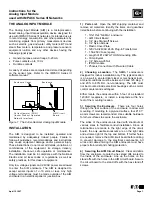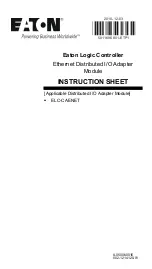
Chapter 3
Theory of Operation
© National Instruments Corporation
3-15
AT-MIO-16D User Manual
The Am9513A OUT2 pin can be used in several different ways. If the LDAC bit is set in
Command Register 2, an active low pulse on OUT2 updates the analog output on the two DACs.
OUT2 can also be used to trigger interrupt requests. If INT2EN bit is set, an interrupt occurs
when a rising edge signal is detected on OUT2. This interrupt can be used to update the DACs or
to interrupt on an external signal connected to OUT2 through the I/O connector.
Counters 3 and 4 of the Am9513A are dedicated to data acquisition timing and therefore are not
made available for general-purpose timing applications. Signals generated at OUT3 and OUT4 are
provided to the data acquisition timing circuitry. GATE3 is controlled by the data acquisition
timing circuitry.
Counter 5 is sometimes used by the data acquisition timing circuitry and concatenated with
Counter 4 to form a 32-bit sample counter. The SCAN CLK signal is connected to the SOURCE3
input of the Am9513A, and OUT1 is provided to the data acquisition timing circuitry. This allows
Counter 1 to be used to divide the SCAN CLK signal for generating the MUX CTR CLK signal
(see the
Data Acquisition Timing Circuitry
section earlier in this chapter).
Counter 2 is sometimes used by the data acquisition timing circuitry to assign a time interval to
each cycle through the scan sequence programmed in the mux-gain memory. This mode is called
interval channel scanning. See the
Multiple-Channel (Scanned) Data Acquisition
section earlier in
this chapter.
The Am9513A 3-bit programmable frequency output channel is provided at the I/O connector
FOUT pin. Any of the five internal timebases and any of the counter SOURCE or GATE inputs
can be selected as the frequency output source. The frequency output channel divides the selected
source by its 4-bit programmed value and provides the divided down signal at the FOUT pin.
RTSI Bus Interface Circuitry
The AT-MIO-16D is interfaced to the National Instrument RTSI bus. The RTSI bus has seven
trigger lines and a system clock line. All National Instruments AT Series boards with RTSI bus
connectors can be wired together inside the PC AT and share these signals. A block diagram of the
RTSI bus interface circuitry is shown in Figure 3-8.
Содержание AT-MIO-16D
Страница 16: ......
Страница 23: ......
Страница 185: ......
Страница 206: ......
Страница 207: ......
Страница 208: ......
Страница 209: ......
Страница 210: ......
Страница 211: ......
Страница 212: ......
Страница 213: ......
Страница 214: ......
Страница 215: ......
Страница 216: ......
Страница 217: ......
Страница 218: ......
Страница 219: ......
Страница 220: ......
Страница 221: ......
Страница 222: ......
Страница 223: ......
Страница 224: ......
Страница 225: ......
Страница 226: ......
Страница 227: ......
Страница 228: ......
Страница 229: ......
Страница 230: ......
Страница 231: ......
Страница 232: ......
Страница 233: ......
Страница 234: ......
Страница 235: ......
Страница 236: ......
Страница 237: ......
Страница 238: ......
Страница 239: ......
Страница 240: ......
Страница 241: ......
Страница 242: ......
Страница 243: ......
Страница 244: ......
Страница 246: ......
Страница 247: ......
Страница 248: ......
Страница 249: ......
Страница 250: ......
Страница 251: ......
Страница 252: ......
Страница 253: ......
Страница 254: ......
Страница 255: ......
Страница 256: ......
Страница 257: ......
Страница 258: ......
Страница 259: ......
Страница 260: ......
Страница 261: ......
















































